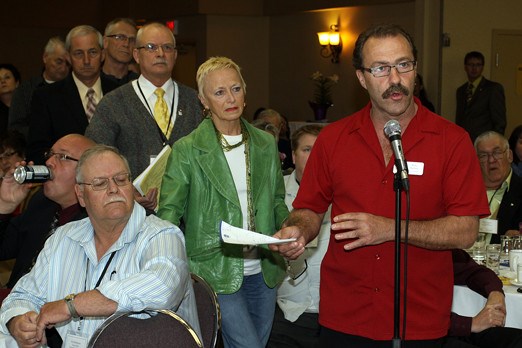Wood allocation, a shortage of skilled workers and a lack of outhouses along the Trans-Canada Highway were the hot topics on Friday during a bear-pit session between municipal leaders and provincial ministers.
Thunder Bay city manager Tim Commisso, excited by the possibilities afforded by the Ring of Fire development, nonetheless questioned Mines Minister Michael Gravelle where the miners would come from.
“I guess what I’m trying to get a handle on, in the context of the Growth Plan, where we see that as a huge opportunity for the region, how are you looking at tying together what is an opportunity with what is imminently looks like will be a significant shortage in an area that certainly could allow the area to prosper over the next 15 to 20 years, if not sooner than that?” Commisso asked.
John Milloy, the minister of training, colleges and universities, said the province recognizes the economy is in transition and said they’ve worked with the colleges across Ontario to prepare students to make the move into new sectors.
Mining is first and foremost on their minds, but education doesn’t happen overnight.
“As I think everyone around here knows, it’s not simply about a mine coming in and stating we’re opening, we’re going to be hiring 100 people, ‘Hey, Milloy, set up a two-week training program.’ In many cases you have to start at the beginning with literacy and basic skills, through high-school skills through to the basic training that’s needed,” the minister said.
“We put together the Northern Training Fund, $45 million over three years … in order to tie together all the partners – the employer, the educational institution and obviously the potential students.”
Gravelle said nationwide there is a need for about 90,000 miners, many of which is in Ontario.
“There’s no question this is a big package to pull together, but the mining companies want us to do it, we’ve got the building and trades councils working very hard with Grand Chief (Stan) Beardy and the Aboriginal and Metis Nations as well in recognizing there are some opportunities there and how do we recognize the need,” Gravelle said.
“We all talk Ring of Fire, but we need it now, too. What’s happening now is when people are graduating from mining courses, they’re getting jobs right away. Those jobs are there.”
Marathon Mayor Rick Dumas, on the other hand, questioned why Ontario’s wood allocation process, decided by a province-wide competition, hasn’t moved along quicker, with only 2.3 million cubic metres of timber rights handed out of a promised nine million total.
“What’s going to happen to that other seven million or whatever is available in the fibre basket? It’s not going to get our people back to work,” Dumas said.
Gravelle, whose portfolio also includes forestry, said the competition is nearing an end and the province recognizes the need to get through the process in order to move to the next stage and third reading of the controversial legislation, which the ruling Liberals altered after first presenting it to the public in January.
“I can’t tell you exactly when each and every piece of the nine million cubic metres will be used, but the wood itself will be used in some fashion and potentially can be used as one of the local forest management corporation pilots. But we are moving as quickly as we can,” Gravelle said.
“I almost apologize for it, because it is a complex project.”
Nipigon Coun. James Foulds expressed concern that the province is spending too much effort worried about caribous and their habitats, while ignoring the plight of the common moose.
“We feel the moose population is declining and the economic benefits from the moose population tenfold to protecting a species of caribou,” Foulds said.
Minister of Natural Resources Linda Jeffries said she can’t play favourites about which animal she likes better, but said they are monitoring the moose population closely.
“There have been changes and certainly the moose tag process has been one we’ve been looking at over the last couple of years because each zone has s different population and some are doing better than others,” Jeffries said.
“It’s a balancing act. There are times when you think you’ve got the population heavy and stable and you just have to cross a valley and they’re not in such good shape, whether it’s disease or predation or whatever.”
Not everyone was quite so serious in their requests of the government.
Coun. Gwen Garbutt of O’Connor Township said she’s driven by a Ministry of Transportation depot in Thunder Bay and seen a stockpile of outhouses sitting unused.
They’re not doing anyone any good locked behind a fence, Garbutt said.
“I’m going to Geraldton at the end of the month, and I have to go for a pee at least 50 times. That’s a lie, but its close enough. Let’s get these things out. I think I’ve been bringing this up since time began. We really need these rest stops,” she said, a burst of applause sounding behind her.
In this case, the politicians agreed.
“I’m with you on this Gwen,” Gravelle said, promising to look into the problem.
Sign in or register
- Messages
- Post a Listing
- Your Listings
- Your Profile
- Your Subscriptions
- Your Likes
- Your Business
- Support Local News
- Payment History
Registered Users
Already have an account?
New Users
Create a free account.
